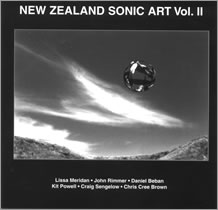Compact discs, 2000 (NZSA 2000), 2001
(NZSA Volume II); available from The University of Waikato, Department
of Music, Private Bag 3105, Hamilton, New Zealand MDWU1201; World Wide
Web www.waikato.ac.nz/music/nzsonicart/.
Reviewed by Jim Hearon
San Francisco, California, USA
 New Zealand Sonic Art 2000, and New
Zealand Sonic Art Volume II, are compact discs from the Digital Music Studios of
the Department
of Music at The
University of Waikato, Hamilton, New Zealand. These two CDs feature
electroacoustic compositions selected from a group of lecturers,
composers, and senior
lecturers following a call for works from New Zealand citizens and
permanent residents. The first recording was made possible by
an initial grant from
the School of Humanities Research Fund at the University of Waikato.
The series is produced under the artistic direction of Ian Whalley,
with studio
engineering and graphic design assistance from Kim Walker and William
Dart. The result is an excellent series that continues to grow,
with plans announced
for Volume
III.
New Zealand Sonic Art 2000, and New
Zealand Sonic Art Volume II, are compact discs from the Digital Music Studios of
the Department
of Music at The
University of Waikato, Hamilton, New Zealand. These two CDs feature
electroacoustic compositions selected from a group of lecturers,
composers, and senior
lecturers following a call for works from New Zealand citizens and
permanent residents. The first recording was made possible by
an initial grant from
the School of Humanities Research Fund at the University of Waikato.
The series is produced under the artistic direction of Ian Whalley,
with studio
engineering and graphic design assistance from Kim Walker and William
Dart. The result is an excellent series that continues to grow,
with plans announced
for Volume
III.
The first two discs pay homage to one of New Zealand’s most famous pioneers of electronic music: composer and teacher, Douglas Lilburn (1915-2001). During the 1930s, after winning a composition prize offered by Percy Grainger, Mr. Lilburn attended the Royal College of Music in London and became a student of Ralph Vaughan Williams. In the 1960s he visited Darmstadt and also worked in the electronic music studios at the University of Toronto. In 1966 he established the Electronic Music Studio at Victoria University in Wellington, the first in New Zealand or Australia. It was in 1975 that he turned his attention exclusively toward the composition of electronic music. It’s a pity none of Mr. Lilburn’s pieces have yet been included in the series.
As compilations go, these CDs work very well in terms of unity of mood, technique, and pacing. The final mastering is very well done and provides a smooth listening experience from beginning to end. New Zealand Sonic Art 2000, the first in the series, features works by John Young, John Elmsly, Michael Norris, Miriama Young, Chris Cree Brown, John Rimmer, Matthew Suttor, Lissa Meridan, and Dugal McKinnon. Emphasizing electronic and digital processes presented in refined technical detail, the works on the CD are all consistent with high quality academic digital music studio production. As a point of researching influences, it would be interesting to compare some of Mr. Lilburn’s electroacoustic works with the pieces in the current collection, but his LP recordings are now out of print. The Kiwi-Pacific 3-LP boxed set, New Zealand Electronic Music (KIWI SLD-44/46, 1975), for example, featured some of Mr. Lilburn’s early electronic works and showed some of his experimentation in the medium he valued so highly, the new found love of which he apparently passed along to many young composers. Another LP, Soundscape (KIWI SLD-59, 1979), was entirely works by Mr. Lilburn, but both are unavailable, and have not yet been remastered for digital media.
 New Zealand Sonic Art Volume II (2001), the second
of the series, features works by Lissa Meridan, John Rimmer, and Chris
Cree Brown—all composers
from the first, as well as compositions by Daniel Beban, Kit Powell,
and Craig Sengelow. Mr. Beban’s Herakles is fuel for an entire
CD in itself, featuring humdrum sounds from the gym and squash court,
the clang
and clatter of dumbbells, high-pitched screeching of rubber tennis
shoes against the squash court floor, as well as the grunts, groans,
and shouts
of weightlifters. The natural sounds all help to create a kind
of rhythmic randomness and cacophony akin to a high-octane, Derek Bailey
improvised
guitar solo. Therein lies the affinity to utilizing natural sounds
in an experimental manner where Mr. Beban along with groups such as
Dooblong
Tondra and International Observer are heirs apparent to the legacy
of Mr. Lilburn’s experimentation in the electronic medium.
New Zealand Sonic Art Volume II (2001), the second
of the series, features works by Lissa Meridan, John Rimmer, and Chris
Cree Brown—all composers
from the first, as well as compositions by Daniel Beban, Kit Powell,
and Craig Sengelow. Mr. Beban’s Herakles is fuel for an entire
CD in itself, featuring humdrum sounds from the gym and squash court,
the clang
and clatter of dumbbells, high-pitched screeching of rubber tennis
shoes against the squash court floor, as well as the grunts, groans,
and shouts
of weightlifters. The natural sounds all help to create a kind
of rhythmic randomness and cacophony akin to a high-octane, Derek Bailey
improvised
guitar solo. Therein lies the affinity to utilizing natural sounds
in an experimental manner where Mr. Beban along with groups such as
Dooblong
Tondra and International Observer are heirs apparent to the legacy
of Mr. Lilburn’s experimentation in the electronic medium.
Libraries, schools, researchers, and individuals interested in
the sonic references of New Zealand will find these CDs a very
valuable
addition
to any growing international collection, and well worth the cost
of the purchase.